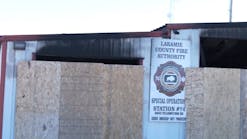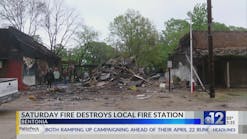W.Va. Fire Safety Education Scrutinized Following Deadly Blaze
Source The Charleston Gazette, W.Va. (MCT)
It’s unclear if a working smoke detector could have saved Zachary McDaniel, 9, and Aubree McDaniel, 3, from the fire that killed them last Sunday morning at their home in Scott Depot.
West Virginia Assistant Fire Marshal Shawn Alderman said investigators found no evidence of a detector in the burned out trailer in the Nottingham Mobile Home Park, although he cautioned that that doesn’t mean there wasn’t one there. Alderman and other fire officials said detectors significantly increase the likelihood of surviving a blaze. However, they didn’t want to speculate on the Scott Depot case. Putnam County Prosecuting Attorney Mark Sorsaia is still considering whether to file charges against the children’s parents or guardians.
No state or local agency was responsible for checking that the parents or guardians were maintaining the detectors required in the home — West Virginia law actually forbids the Fire Marshal’s Office from inspecting one- and two-family homes. However, a 2012 audit concluded that the Fire Marshal’s Office and the state Fire Commission that leads it weren’t putting enough effort into public fire-safety education to fulfill their statutorily required mission to reduce the state’s “grossly unacceptable fire death rate.”
Fire Marshal Anthony Carrico said that, of the 38 fire deaths so far this year, the “vast majority” have occurred in single- and double-family homes. A 2013 National Fire Protection Association report found that, nationwide, 84 percent of home fire deaths occurred in one- and two-family homes.
According to the organization, West Virginia averaged 16.8 unintentional fire deaths per million residents from 2006-10 — the 10th-highest death rate in the nation. Nine of the 10 states with the highest death rates are in the South. Carrico said West Virginia’s poverty and rural nature probably are the two largest contributors to the state’s high death rate.
Even if the Fire Marshal’s Office were allowed to inspect smaller homes for detectors, Carrico said it would be very difficult for his already busy personnel to inspect or give detectors to every home in the state. Like the audit, he agreed that public education is the most effective way to bring down the state’s death rate.
The 2012 report by the State Auditor’s Office found that the Fire Marshal’s Office wasn’t complying with recommendations it made as far back as 2000 to “devote greater resources to public education.” The report noted that the public education officer, whose job includes being a spokesperson for the Fire Marshal’s Office and coordinating fire-safety education events, appeared to be overburdened. The audit said the Governor’s Office had reallocated four employees who had been helping the public education officer to different tasks within the Division of Homeland Security and Emergency Management.
“The reduction of personnel makes it difficult to enhance existing fire prevention/safety programs or establish new programs despite available funds for such programs,” the audit stated.
Carrico said his office doesn’t have a full-time public education officer. He said the role has been vacant for about a year and that the Fire Commission directed him just last month to begin moving toward filling the position. The position’s duties are being handled by Mark Lambert, who is also the office’s chief investigator.
Carl Sizemore, who became chairman of the Fire Commission in August and has served on the board since 2009, said a $4.3 million cut in the agency’s budget contributed to the public education position remaining unfilled.
“We’ve addressed the best we could with our circumstances,” Sizemore said, noting the public education officer’s retirement and the uncertainty of the fire marshal’s position.
He said that since Carrico was promoted from acting to permanent fire marshal in October, he’s been instructed to lay out his plans for public education.
The agency has launched a Facebook page within the past three months, Carrico said, and is planning to push for a law requiring residential sprinkler systems in new houses.
Carrico said the audit report, which was released before he became acting fire marshal in May 2013, was, in some ways, an “unfair assessment” of the office. He said duties the public education officer previously was responsible for have been transferred elsewhere, so the new person in the role will be more focused on outreach.
“I’m trying to create that as a civilian standalone position, just focused solely on public fire-prevention education,” Carrico said.
He suggested that public education would best be conducted by local fire departments. There are 419 volunteer fire departments across West Virginia, and 26 with either all full-time firefighters or a combination of full-timers and volunteers.
“It think it’s impractical for a representative of the Fire Marshal’s Office to be in every school in the state, other than for annual inspections, when the locals could do them just as well, if not better.” Carrico said.
He said that, before the previous public education officer retired, she’d sent surveys to 442 of the 445 fire departments, but only 144 responded. About 94 percent of those respondents said they had a public education program of some type, but 64 percent said it was only functional during Fire Prevention Week, which occurs every October.
The 2012 audit also criticized the Fire Marshal’s Office and the Fire Commission for not better coordinating public education within local departments. It found that the Fire Commission and the public education officer were delegating to the local departments without knowing each community’s basic fire-prevention needs or if they were being met.
“The lack of staff is understandably a difficult issue,” the audit stated. “Although the Commission has made some attempts of coordinating fire safety programs with fire departments, it is clear that coordination has not been accomplished.”
John Smoot — chief of the Teays Valley Fire Department, which was first on the scene at the Scott Depot fire — said that, historically, his department focused on outreach only during October. Recently, it began doing open houses at other times in recognition of the agency’s 50th anniversary.
Smoot said the fire department ran education programs last month at Scott Teays Elementary School — where Zachary McDaniel was enrolled — but only for kindergarten and first-grade classes. He said the department usually gets to educate every grade level in all six schools it visits annually.
In response to the deaths — which Smoot said are the only child fatalities he can remember in his nearly 25 years with the department — his agency is working on a program that could reach every grade at Scott Teays Elementary, if not every class. He also intends to increase education efforts more generally.
“Every opportunity we get to bring students in, we do it,” Smoot said, “but we believe we still need to up our game in outreach.”
Reach Ryan Quinn at [email protected], 304-348-1254 or follow @RyanEQuinn on Twitter.
———
©2014 The Charleston Gazette (Charleston, W.Va.)
Visit The Charleston Gazette (Charleston, W.Va.) at www.wvgazette.com
Distributed by MCT Information Services





